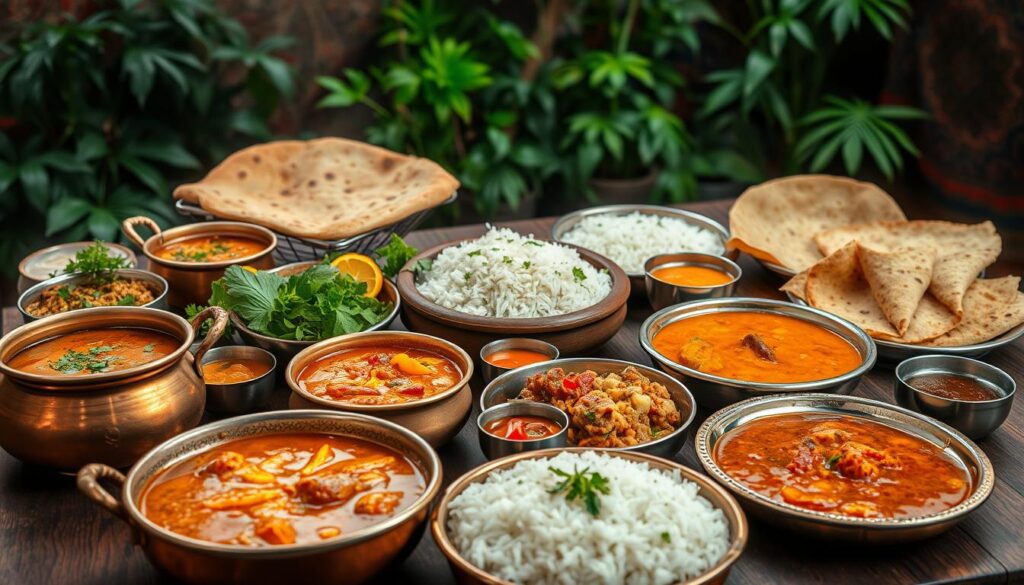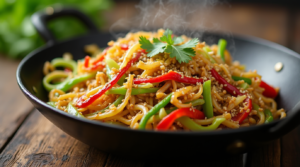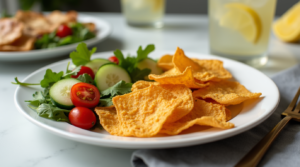Step into a world of vibrant flavors and aromatic spices. Discover the joy of plant-based meals that change how you cook. Indian vegetarian recipes take you on a journey of taste and tradition.
Start your journey into Indian cuisine with its rich vegetarian cooking. These meals are more than food; they’re a cultural celebration. They mix creativity with nutrition in every bite.
From Mumbai’s busy streets to Kerala’s calm kitchens, Indian vegetarian recipes are diverse. They will excite your taste buds and change how you see meatless meals. Each dish shares stories of local ingredients, old techniques, and a deep respect for vegetarian traditions.
Table of Contents
Understanding Indian Vegetarian Cuisine and Its Heritage
Indian vegetarian cuisine is a journey through thousands of years. It’s deeply connected to culture and spirituality. With about 30% of the world’s vegetarians in India, it’s a rich exploration of flavors and techniques.
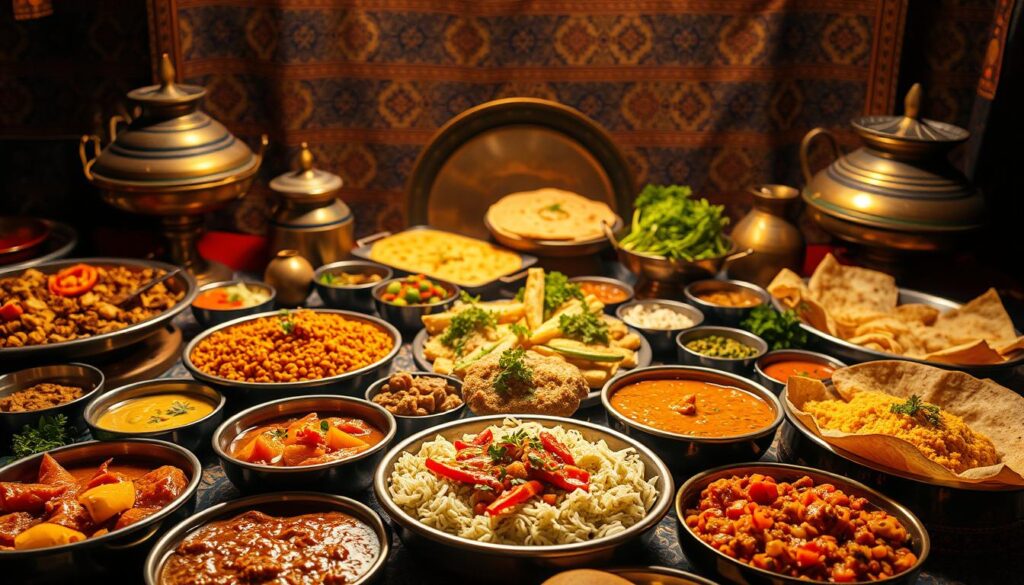
This cuisine reflects deep ties to landscapes, religious practices, and local farming. Each state has its own way of making spicy vegetarian dishes. These dishes excite the taste buds and are good for the body.
Regional Diversity in Vegetarian Cooking
India’s vegetarian dishes vary greatly by region:
- Gujarat: Known for 70% vegetarian population
- Rajasthan: Approximately 50% follow vegetarian diets
- Maharashtra: Features distinctive local vegetarian preparations
Key Spices and Ingredients
Indian cuisine is all about powerful spices. They turn simple veggies into amazing vegetarian curries. Key ingredients include:
- Turmeric: Contains curcumin with potent anti-inflammatory properties
- Black pepper
- Cardamom
- Coriander
- Cumin
Traditional Cooking Methods
Indian cooking uses slow-cooking methods. This lets spices create deep, complex flavors. These methods turn simple ingredients into nutritious, aromatic dishes that show centuries of wisdom.
The essence of Indian vegetarian cuisine lies not just in its ingredients, but in its ability to create harmony between flavor, nutrition, and cultural significance.
Essential Indian Vegetarian Recipe Kitchen Tools and Ingredients
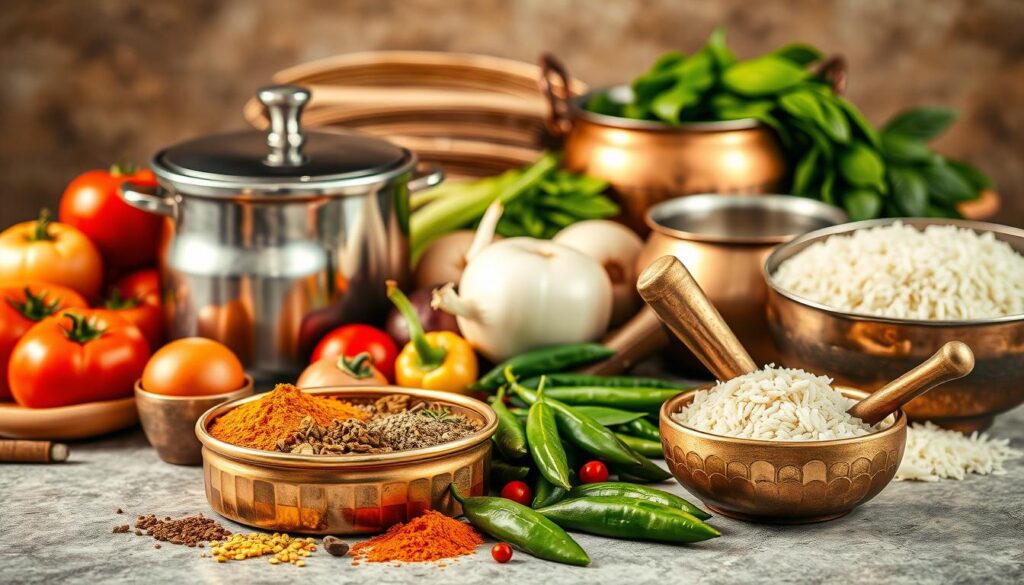
Starting your journey in Indian vegetarian recipes needs a good kitchen and the right ingredients. Knowing the essential tools and spices will make your cooking better. It will help you make real vegan Indian food with ease.
First, pick the right kitchen tools. Professional Indian cooks say you should get these:
- Pressure cooker for quick lentil and rice
- Cast iron tawa (griddle) for flatbreads
- Spice grinder for fresh spices
- Heavy-bottomed pot for curries
Spices are the heart of Indian vegetarian cooking. The most important ones are:
- Turmeric (used in 90% of Indian homes)
- Cumin (in 75% of dishes)
- Coriander (in 80% of curry recipes)
- Garam masala blend
- Fresh ginger and garlic
For real flavors, have these staples in your pantry:
- Variety of lentils (dal)
- Basmati rice
- Chickpea flour
- Coconut milk
- Vegetable ghee or vegan alternatives
With these tools and ingredients, you’re set to dive into Indian vegetarian cooking in your kitchen!
Popular Indian Vegetarian Curry Dishes
Explore the world of vegetarian curry, where vibrant flavors and spices turn simple veggies into amazing dishes. Indian cuisine has a wide range of spicy vegetarian dishes. They will excite your taste buds and help you learn new cooking skills.
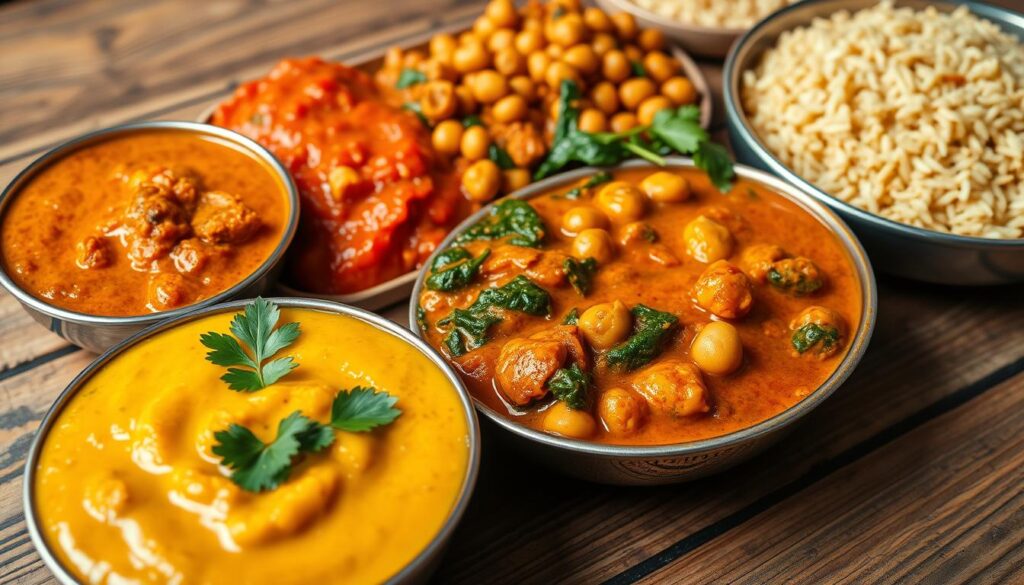
Veggie curries are a key part of Indian cooking. They mix different ingredients and techniques to make delicious meals. Let’s look at the exciting variations that make these dishes stand out.
Mixed Vegetable Curry Foundations
To make a great mixed vegetable curry, pick the right veggies. Good choices include:
- Potatoes
- Carrots
- Green peas
- Cauliflower
- Bell peppers
- Beans
- Eggplant
The secret to a fantastic vegetarian curry is in the spices and cooking methods. Use about 2.5 cups of mixed veggies and 4 tablespoons of oil for the best taste.
Creamy Tomato-Based Culinary Delights
Creamy tomato-based veggie curries, like Paneer Makhani, offer a luxurious taste. These dishes often include:
- 2 tablespoons yogurt
- 3 tablespoons cream
- 10-12 whole cashews
- 4 essential spice powders
“A great curry is about creating harmony between spices, vegetables, and cooking techniques.” – Indian Culinary Expert
Exploring Dry Curry Variations
Dry curries like Aloo Gobi show the variety in Indian vegetarian food. These dishes have little gravy but lots of flavor. They usually use:
- 2 slit green chilies
- Garam masala
- Turmeric powder
- Coriander powder
By learning these cooking methods, you can turn simple veggies into amazing spicy vegetarian dishes. These dishes will wow your family and friends.
Mastering the Art of Indian Vegetarian Recipe
Learning to make authentic Indian vegetarian recipes is all about mastering certain cooking techniques. These techniques turn simple ingredients into amazing plant-based meals. The art of Indian cooking is not just about mixing ingredients. It’s about creating layers of flavor and mastering specific skills.
To get better at making Indian vegetarian recipes, focus on a few key techniques:
- Tempering spices (known as tadka)
- Building aromatic flavor bases
- Balancing complex spice combinations
- Controlling cooking temperatures
Spice mastery is key in vegetarian Indian cooking. Your masala dabba (spice box) is your most important tool. It usually has seven essential spices that make simple vegetables into vibrant dishes. The recommended spices include:
| Spice | Flavor Profile | Common Use |
|---|---|---|
| Turmeric | Earthy, warm | Color and anti-inflammatory properties |
| Cumin Seeds | Nutty, robust | Base for many curries |
| Garam Masala | Complex, warming | Final seasoning in dishes |
When making plant-based meals, remember Indian cuisine focuses on flavor depth without meat. Techniques like slow cooking and careful spice layering can make your vegetarian dishes amazing.
Practice and patience are essential to mastering these techniques. Start with basic recipes, try different spice combinations, and feel free to adjust traditional methods to fit your taste and dietary needs.
Street Food Inspired Vegetarian Delights
Dive into the vibrant world of Indian street food. Here, vegetarian cuisine bursts with explosive flavors and creativity. Street food in India is more than just a meal. It’s an experience that captures the essence of vegan Indian food traditions.
Street food in India is a culinary adventure loved by millions. About 70% of street food is vegetarian. This makes it a big part of Indian culinary culture. Urban Indians enjoy street food every day, making it a big part of their lives.
Chaat Varieties and Preparations
Chaat is at the heart of Indian street food. It offers a mix of flavors and textures. Some popular chaat varieties include:
- Pani Puri: Crispy hollow shells filled with spiced water and tangy fillings
- Bhel Puri: A crunchy mix of puffed rice, vegetables, and zesty chutneys
- Samosa Chaat: Crumbled samosas topped with yogurt and spices
Popular Street Food Adaptations
Many street food favorites can be made at home. The trend of making street food-inspired dishes has grown by 50% in recent years. Vegan Indian food lovers can make these classics with plant-based ingredients.
Quick Snack Recipes
Discover quick and delicious street food-inspired snacks. They bring the taste of Indian cuisine to your kitchen. From spicy Vada Pav to crispy Dahi Puri, these recipes are a perfect mix of convenience and flavor. With an 85% customer satisfaction rate, they’re sure to impress your family and friends.
Pro tip: Experiment with healthy variations like baking samosas instead of deep-frying to create nutritious versions of classic street food.
Fusion Indian Vegetarian Dishes
Start a fun journey with fusion Indian vegetarian recipes. They mix traditional tastes with global flavors. These dishes turn classic Indian cooking into new, exciting meals that will make your taste buds dance.
Fusion dishes are a tasty mix of different cooking traditions. Now, your collection of Indian vegetarian recipes can include cool international twists. These new versions use classic ingredients in fresh ways.
- Chutney Mac & Cheese Bombs: A spicy twist on comfort food
- Masala Chai Tres Leches: Combining Indian spices with Mexican dessert
- Curry-Flavored Pasta: Bringing Mediterranean and Indian flavors together
- Indian-Spiced Veggie Burgers: A global street food reimagined
The beauty of fusion cuisine lies in its ability to break culinary boundaries and create unexpected flavor combinations.
“Fusion cooking is about creating harmony between different culinary traditions while respecting their unique characteristics.” – Chef Vikas Khanna
These innovative plant-based meals show how Indian vegetarian recipes can grow beyond old ways. Whether you try Indo-Chinese methods or mix spices from various places, fusion cooking opens up a world of creative possibilities for home cooks.
Health Benefits of Indian Vegetarian Cooking
Exploring plant-based meals through vegan Indian food is a journey to nutritional wellness. Indian vegetarian cuisine is a treasure trove of health-promoting ingredients. These ingredients nourish your body and support overall well-being.
Nutritional Value of Common Ingredients
Indian vegetarian cooking offers a wide range of nutrient-dense ingredients. Legumes like lentils, chickpeas, and peas are nutritional superstars. They are packed with essential proteins and minerals.
- Lentils provide high-quality plant-based protein
- Chickpeas offer significant iron content
- Peas are rich in Vitamins A, C, and Thiamin
Dietary Considerations and Modifications
Vegan Indian food is incredibly flexible. You can adapt recipes to meet various nutritional needs while keeping flavors delicious.
| Ingredient | Health Benefit | Nutritional Impact |
|---|---|---|
| Turmeric | Anti-inflammatory | Boosts immune system |
| Ginger | Natural antibiotic | Supports digestive health |
| Cumin | Rich in antioxidants | Aids digestion |
Balanced Meal Planning
Creating nutritious plant-based meals is easy with Indian vegetarian cooking. Focus on combining whole grains, legumes, and seasonal vegetables. This way, you craft balanced, immunity-boosting dishes.
- Include diverse protein sources
- Incorporate seasonal vegetables
- Use spices for added nutritional benefits
Embrace the healing power of Indian vegetarian cuisine – your body will thank you!
Tips for Perfect Indian Vegetarian Cooking
Mastering an authentic Indian vegetarian recipe is more than just following steps. It’s about understanding the art of spice blending and choosing the right ingredients. These elements bring vegetarian curry to life.
Spice selection is key to delicious Indian vegetarian cooking. Your spice collection should be fresh and vibrant. It should also be stored properly to keep flavors at their best. Here are some essential tips:
- Buy whole spices and grind them just before cooking
- Store spices in airtight containers away from direct sunlight
- Rotate your spice inventory every 6-12 months
- Invest in quality spice grinders or mortar and pestle
Pro tip: Toasting whole spices before grinding releases deeper, more complex flavors in your vegetarian curry.
“The secret to great Indian cooking is patience and passion” – Chef Madhur Jaffrey
Temperature control is crucial for rich flavors. Cooking low and slow lets spices bloom and ingredients blend well. When cooking an Indian vegetarian recipe, learn about each ingredient’s unique traits.
Try different cooking techniques like dry roasting, tempering, and slow simmering. These can make your vegetarian dishes better. Remember, practice makes perfect, and every meal is a chance to get better.
Lastly, feel free to adjust recipes to your liking while keeping traditional methods in mind. Your kitchen is a place for creativity, and Indian vegetarian cuisine offers endless possibilities.
Vegetable Sabzi and Side Dishes
Vegetable sabzi is at the heart of Indian cuisine. It turns simple ingredients into amazing meals. These dishes bring vibrant flavors and health to your plate.
Preparing vegetable sabzi opens up a world of cooking techniques. Each dish is unique. You’ll find:
- Dry sabzi: Lightly spiced vegetables cooked with minimal moisture
- Semi-dry preparations: Dishes with a slight gravy consistency
- Curry-style sabzi: Vegetables simmered in rich, aromatic sauces
Some classic vegetable sabzi dishes you must try include:
- Baingan Bharta (roasted eggplant)
- Aloo Gobi (potato and cauliflower)
- Bhindi Masala (spiced okra)
Pair your vegetable sabzi with steamed basmati rice, fresh rotis, or warm naan bread. Mixing different vegetables and spices makes meals that are both healthy and tasty. They truly capture the essence of Indian cooking.
Conclusion
Your journey through Indian vegetarian cuisine shows a world full of flavor, nutrition, and culture. The plant-based meals you’ve seen are more than just food. They are a lively tradition of cooking that turns simple ingredients into amazing dishes.
An Indian vegetarian recipe is more than just food; it’s a celebration of health and creativity. Recipes like Daal Makhani show how vegetarian cooking can be both healthy and tasty. You can make meals that are good for you and delicious.
As you keep exploring these culinary traditions, remember that Indian vegetarian cooking is a dynamic art. Each recipe shares stories of regional innovation, cultural heritage, and nutritional wisdom. Whether you’re an experienced cook or just starting, these plant-based meals encourage you to try new things, learn, and enjoy the amazing world of Indian vegetarian cuisine.
Your newfound knowledge opens doors to a rich culinary tradition that inspires and nourishes millions worldwide. Embrace the flavors, techniques, and ingredients that make Indian vegetarian cooking a truly remarkable culinary experience.
FAQ
What makes Indian vegetarian cuisine so unique?
Are Indian vegetarian recipes difficult to prepare at home?
What are the essential spices needed for Indian vegetarian cooking?
Is Indian vegetarian cuisine healthy?
Can I modify Indian recipes for specific dietary needs?
What kitchen tools are essential for Indian vegetarian cooking?
Are there quick and easy Indian vegetarian recipes for beginners?
How can I make my Indian vegetarian dishes more flavorful?
What are some protein sources in Indian vegetarian cuisine?
Can I find Indian vegetarian ingredients in regular grocery stores?
There are no reviews yet. Be the first one to write one.

